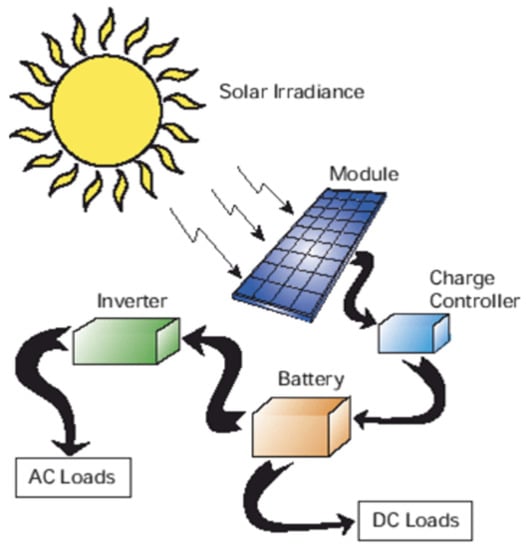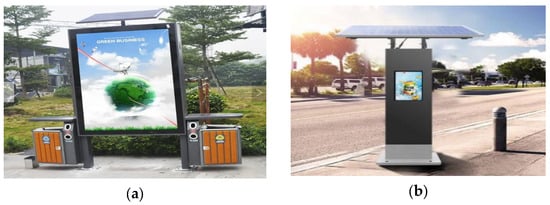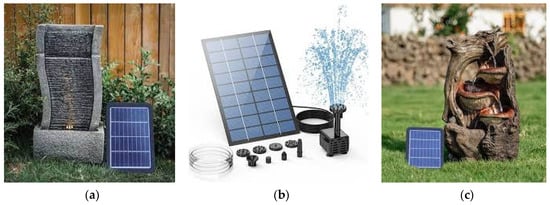You're using an outdated browser. Please upgrade to a modern browser for the best experience.
Please note this is a comparison between Version 1 by Mukhtar SABIU Yahuza and Version 2 by Camila Xu.
The use of solar energy as an alternative source of energy is a natural reflection of technological progress to meet the growing needs of modern life applications. Since solar energy is a relatively new scientific field, specialized research centers have been established to conduct theoretical and applied experiments and to employ the various available resources in order to achieve the desired goal of renewable energy sources in their various uses.
- solar energy
- urban furniture
- Dr. Fazil Kucuk Park
- Nicosia
1. Introduction
The use of solar energy as an alternative source of energy is a natural reflection of technological progress to meet the growing needs of modern life applications. Since solar energy is a relatively new scientific field, specialized research centers have been established to conduct theoretical and applied experiments and to employ the various available resources in order to achieve the desired goal of renewable energy sources in their various uses [1]. The incorporation and use of solar energy in urban furniture is a sustainable and innovative approach to urban design and can reduce the carbon footprint and environmental impact of urban furniture, while offering benefits that are cost-effective, practical, and aesthetic [2]. This has helped in the development of viable and environmentally friendly technologies in this field, and the development of these sources is of strategic importance for any country.
Cyprus is one of the countries that is exposed to large amounts of solar radiation for long hours throughout the year, and the abundance of solar energy in Cyprus imposes the idea of using the sun as a source of electrical energy. Therefore, a study was initiated to examine the possibility of relying more on natural energy sources as an alternative to commercial sources. Humans interact with the surrounding environment in terms of functionality and aesthetics, and one of these environmental elements is urban furniture, which needs to keep up with modern technology and keep an eye on the latest technological developments in both design and function [3]. Hence, the research problem arose by asking: What is the role of solar energy and its relationship to urban furniture?
The importance of the research lies in relying on a source of energy that is available all over the world, especially in Cyprus, which enjoys bright sunshine for long periods of time, which can be a benefit. Also, delving into such a topic contributes to creating a knowledge base on the possibility of using solar energy in urban furniture.
2. Solar Energy and Urban Furniture
The solar system consists of two main components that work as one unit to generate electrical energy: the solar panels and the supporting system. The solar panels consist of a number of parts, solar modules that contain a group of solar cells, while the specifications vary for the supporting system according to the requirements of the loads and the requirements of the methods of connecting the systems. The two fundamental components of a solar system are as follows: Solar panels: There are several solar modules in it, and the solar cells. It is the tiniest component of the whole. The support system: It includes a charger, an energy reservoir, a power inverter, a supporting structure, and the cables that connect them. As cities try to lessen their dependency on fossil fuels and implement solar energy, it is playing a bigger role in urban furniture thanks to more ecological practices. Cities can use renewable energy by incorporating solar panels into exterior fixtures like benches, trash cans, and streetlights [4][5]. Urban furniture driven by sunlight can assist lower energy expenses over time, which is one of its main advantages. For instance, a study by [5][6] discovered that a bus stop powered by solar can save up to 40% on power expenses compared to conventional bus stops. Similarly, solar-powered streetlights can provide reliable and sustainable lighting for urban areas while also reducing carbon emissions [4][5]. Additionally, solar-powered urban pieces of furniture could offer a number of other advantages, such as offering electrical device charging stations or decreasing waste using solar-powered garbage compactors [6][7]. Moreover, a lot of localities provide grants and rewards for renewable energy projects, which could help with the upfront cost of installing solar-powered urban furniture (see Figure 1).3. Integrating Solar Energy in Urban Furniture Elements
As a renewable energy source for urban furniture, solar energy is gaining popularity. This is because solar panels may be incorporated into many types of urban furniture designs, such as streetlights and benches, to offer a source of sustainable and clean energy [8][9]. Urban furniture that uses solar energy may function without using conventional energy sources, lowering greenhouse gas emissions and the total carbon footprint of cities [9][10]. Additionally, outdoor lighting and charging stations may be made more affordable and low-maintenance by using solar-powered urban furniture. A complete collection of solar-powered urban furniture initiatives was acquired after a thorough analysis of the literature, which included books, newspaper articles, conference papers, and websites. This collection is a useful tool for creating a basic classification scheme for different types of urban furniture that may be created and incorporated using solar technology. Examples of solar-powered urban furniture that may be included and created in public parks include the following.3.1. Solar Lighting
Solar lighting is a form of lighting that illuminates outdoor areas by harnessing the energy of the sun. Solar lighting has greatly increased in popularity over the past several years due to the rising demand for environmentally friendly and energy-efficient lighting. In addition to having financial advantages, solar illumination has major environmental advantages. Solar illumination may help lessen carbon impact by employing natural light, an emission-free and endlessly renewable resource [10][11]. Solar illumination may be installed with little physical disruption because it does not need to be connected to the electricity grid, making it perfect for ecologically sensitive areas, parks, and holy places [11][12]. There are several types of solar lighting systems. These include: Solar garden lights: These are small, decorative lights that are used to light up pathways, flower beds, and other outdoor spaces (see Figure 2c).
3.2. Solar Public Art
The use of solar energy in artwork is an innovative and exciting way to incorporate sustainability and environmental awareness into artistic expression. Solar energy has been utilized for centuries as a source of inspiration for artists, but with the advent of modern solar technology, artists have been able to incorporate this renewable energy source into their work in new and exciting ways. One example of urban furniture that utilizes a renewable energy source, specifically solar energy, is the Love Solar Tree Ross, designed by Ross Lovegrove and produced by Artemide (see Figure 3a–d). This solar tree was showcased during a design week in front of MAK, a contemporary art museum in Vienna that operates on solar energy. The solar energy is harvested from a photovoltaic system and used to power LED lighting, with the goal of reducing environmental impact ([17][18]. Additionally, a hypothetical solar-powered project is the “Mango” design by [18][19] Adam Miklosi, (2012) which took inspiration from India’s heavy monsoon rains and brilliant sunlight. This architectural idea intends to capture and use rainfall for drainage while also capturing solar energy through leaves like those on a mango tree [17][18].
3.3. Solar Benches
A creative way to use solar power in public spaces is to include it in the seating. Solar-powered furniture can offer a practical and environmentally friendly way for users to access Wi-Fi or charge their devices while also offering a relaxing place to sit. Strong solar charging stations called ConnecTables are appropriate for both commercial and domestic use in public areas, including college campuses, office buildings, outdoors shopping malls, and theme parks. These places of charging can be linked together to form a mini-grid that can supply power during protracted power outages (see Figure 4a–d). Each model features two solar panels with a minimum output of 250 watts each, each of which may provide up to 500 watts of energy. In bad weather, ConnecTables require little upkeep, and their electrical parts are completely enclosed to provide user security and vandalism defense. In addition to being made of stainless steel, it has an architectural design [21][22].
3.4. Solar Rubbish Bins
Photovoltaic (PV) panels convert sunshine into power, which is then stored in batteries, to power solar-powered garbage cans. The internal compactor of the garbage-collecting can is then fueled by the previously conserved energy. The garbage gets compressed in the can, as a result lowering its volume and enabling it to hold more rubbish. There are various advantages to using solar energy in trash cans. First, since there is no longer a need for rubbish to be transported (see Figure 5a,b), it reduces the carbon impact of rubbish collection by using trucks driven by diesel instead of gasoline. Second, it lessens the frequency of garbage collection because more waste may be held in a given volume thanks to compaction. As a result, fewer trucks are required for waste collection, which lowers the price of transportation. The compacting of the debris inhibits the wind from dispersing it around the area, which can assist curb littering [26][27].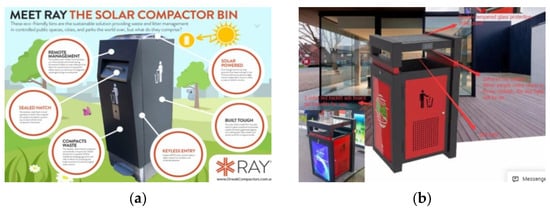
3.5. Solar Billboard
Solar-powered billboards for outdoor advertising use solar energy to power their lighting and display systems, making them sustainable and environmentally friendly. They operate by generating electricity from solar panels, which lowers the energy expenses and carbon footprint of the businesses that use them [28][29]. As a result, sunlight billboards are gaining popularity among companies looking for more eco-friendly and economical advertising strategies. Solar billboards have the benefit of being accessible in places where conventional billboards might not be possible owing to a lack of availability of electricity, as well as to being ecologically beneficial. They also require less upkeep than conventional billboards because they do not require constant replacement of their light bulbs or connection to a power source (see Figure 6).3.6. Solar Electric Bike Stations
An efficient strategy to encourage environmentally friendly transportation and lessen cities’ carbon footprint is to use solar electricity for bicycle parking [31][32]. Solar-powered bicycle parking structures can offer a source of renewable energy for illumination, security, and even electric bicycle charging stations [32][33]. Solar-powered bicycle parking can be less expensive and more environmentally friendly than standard parking structures that rely on grid electricity [33][34]. By generating their own energy, solar-powered bicycle parking facilities can reduce or eliminate electricity bills, making them a more financially feasible option in the long run [31][32]. Furthermore, the use of solar energy in bicycle parking can enhance the safety and convenience of cyclists. With solar-powered lighting and security systems, bicycle parking facilities can provide a safer environment for cyclists to park their bikes, particularly in areas with limited lighting or high crime rates [34][35] (see Figure 7a,b).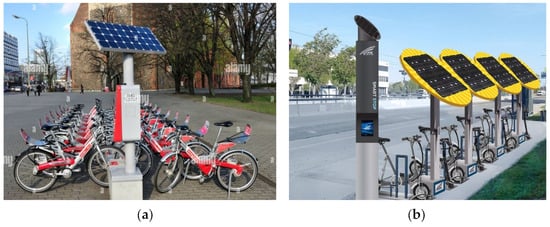
Figure 7.
Use of solar energy in bicycle parking. (
3.7. Solar Pergola
A solar pergola is a solar-panel roof, used to cover a relaxation area in a park, which generates renewable energy in a novel method; it also provides a more seamless and different choice for implementing solar electricity while people relax under the pergola. This solar energy generated using the pergolas not only creates a lovely and useful outdoor living area, but the energy generated might also power some or all of the park, while reducing additional utility costs [37][38]. As a way to harness solar power and encourage sustainability, solar panels are being integrated into a wider range of structures. With their open framework design and aesthetic appeal, pergolas offer a great way to use solar power in park settings. Solar panels can be integrated into pergolas to capture sunlight and convert it into clean, renewable electricity, which lessens reliance on fossil fuels [38][39]. Pergolas with solar panels integrated offer practical benefits in parks in addition to their capacity to generate energy (see Figure 8a–c). They provide visitors to parks with shade and cover, improving the comfort and usability of outdoor spaces, especially in hot weather or during downpours. Additionally, the solar panels serve as a shield, protecting the pergola structure, and the amount of maintenance needed is decreased thanks to this protective function.
Figure 8.
Use of solar pergola in a park. (

